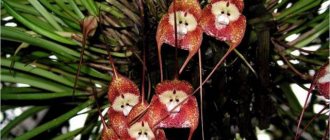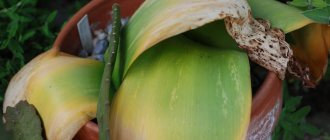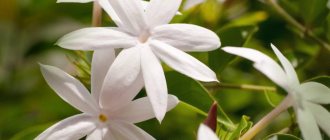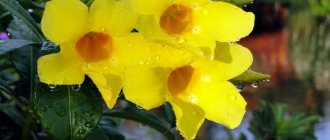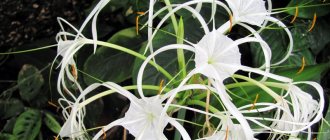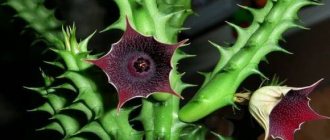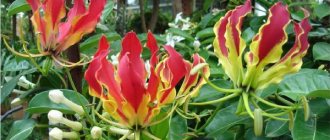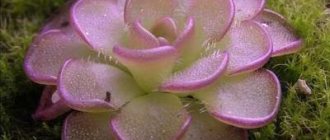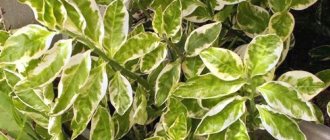Until recently, one could admire the Vanda orchid only in botanical gardens. Flower growers believed that a capricious guest would not take root in the house, because she comes from the tropics, where it’s hot, there is high humidity.
However, if you create the appropriate conditions at home and carefully take care of the plant, the Vanda orchid produces arrows with flowers of unusual beauty.
Types and varieties of Vanda
The Vanda orchid is easy to cross. Many hybrid varieties of Vanda have been bred, and breeders are not losing interest in this beauty. The most attractive species and many interspecific and intergeneric hybrids are grown in culture - variously colored, with beautiful leaves and large flowers. Let us introduce you to the most popular of them.
Blue (Coerulea)
This plant was found in 1837 in the foothills of the Eastern Himalayas at an altitude of 1500 m above sea level. The plant is tall, up to 1 m. It has a powerful, well-developed, hanging root system. The leaves are belt-shaped, dark green, shiny, with an oblique cut at the top. They reach 20 cm in length.
Peduncles are tall, straight, up to 50 cm in length. From 6 to 15 flowers up to 10 cm in diameter are formed on one peduncle. The petals are blue, dove-gray or lavender and covered in a delicate, net-like pattern in a darker shade. Over time, the color lightens and becomes pale blue. Flowering occurs in autumn, in October.
Tender (Suaris)
A very beautiful plant. The bright petals of large white flowers are strewn with purple dots. Flowering usually begins in spring, lasts a long time, and up to 12 buds bloom on one peduncle.
Sandera (Sanderiana)
The pride of the Filipinos, the Sander orchid is, unfortunately, quite rare in the wild. It is classified as a large Vanda species. It has a dense, well-developed root system and long, up to 40 cm in length, beautiful leaves with a forked tip. Peduncle straight, tall. It can accommodate up to 10 large flowers (about 15 cm in diameter) at once. The flowers have a soft pink color on the upper petals, and the lower petals are yellow-red. The lip is large, up to 15 cm, colored simultaneously in yellow and red shades.
This may be interesting: Use of succinic acid for orchids
Rothschildiana
Hybrid type of orchid. This is an epiphyte resulting from crossing Vanda Blue and Sander. Has all the distinctive features of its parents. Only the flowers differ in their large number (up to 20 of them on a peduncle) and smaller size (up to 5 cm in diameter). The color of the petals is blue. The lip is short and dark. The leaves are rough, with forked tips, like Sandera.
Valkovata (Vanda teres)
This is a very large epiphytic plant. In nature, its branched stem stretches to a height of up to 3 m. When kept indoors, the length of the stem is also decent - up to 2 m. The stem (climbing or lodging) has numerous aerial roots. The leaves of this Vanda are 20 cm long and only 3 mm wide. They are located on the stem in two rows.
From 3 to 6 large (7-10 cm in diameter) flowers are formed on the peduncle. The sepals and petals are ovoid or diamond-shaped and have wavy edges. The lip in the center is three-lobed. The lower blade is purple in color and divided in the middle. The side lobes are yellow and decorated with red splashes. Begins to bloom in autumn.
Javiera
A low specimen, up to 50 cm in height. It has dense rows of dark green leaves along the edges. The flowers are medium in size, there are up to 12 of them on a peduncle. Both the petals and the lip are snow-white.
Tricolor
This epiphyte is very tall and can grow up to one and a half to two meters in height. The leaves are elongated, belt-shaped, rough, up to 40 cm in length, arranged on the stem in two rows. Vanda got its name for the original shape and color of the flowers: brown spots are scattered across the white-cream field of petals. The central lobe of the lip is pink-violet. The wavy edges of the petals add special beauty. Blooms 2 times a year: May–June, October–January. Up to 10 flowers up to 7 cm in diameter can simultaneously fit on one peduncle. The flowers smell nice.
Norbert Alphonso
The plant is medium tall, about 90 cm in height. The flower stalks are medium. Each one has from 10 to 15 large flowers with pink petals. The lip is wrapped in an original burgundy tube.
Great
A large orchid native to the Maltese Islands. It has a thick stem with tough long leaves. The flowers are yellow-brown in color with a diameter of up to 5 cm. Flowering occurs in the summer and lasts for several months.
Chess (Tessellata)
The height of the plant is one and a half to two meters. The leaves are greenish, densely located along the entire length of the stem so that they hide it. Up to 12 large buds of beige or, more often, brownish color are formed on the peduncle. The lip is painted in bright purple tones. Flowering is accompanied by a pleasant aroma.
Comb (Cristata)
It has a strong aroma and original lip color.
In glass
Vanda orchids look elegant in glass vases. But not every vessel can become a home for a beauty. It is better to use conical, goblet-shaped objects that gradually expand downward. A common mistake florists make is that the vanda is completely buried in the container.
In this position, the leaves do not receive additional sunlight and may rot from the ingress of liquid. It is necessary that only the roots are in the vase. Hydrogel can be placed on the bottom.
Vanda flowering
Care during flowering
Vanda does not have a clearly defined dormant period, and it can bloom all year round, especially in the spring and summer, since at this time there is long daylight. On average, flowering lasts 6-8 weeks, but can sometimes last up to three months. The vanda flower is an amazing creation of nature, and if you have seen it once, you will want to see it again. By observing all agrotechnical requirements for flower care, you have the right to count on the fact that the vanda will bloom annually and even more than once.
If you're concerned that your orchid isn't blooming, it could be that it's not getting enough light, or the difference between day and night temperatures is less than eight degrees, or maybe you've overfed the orchid with nitrogen.
Vanda after flowering
When the vanda orchid has finished blooming, cut off the flower stalks and keep the roots less moist by soaking the roots in a container of warm water once a week. Spraying should also be stopped for a while. If you have the opportunity, take the vanda into the garden, hang it on a tree or place it on the balcony, on the terrace, where the conditions suit it, and care for it as before flowering. Fresh air will definitely do her good.
Temperature and light
A bright, well-ventilated space is best for the vanda. If a window sill is selected, then the window should face east, south, southwest.
Daylight hours should not be less than 12 hours, so in the autumn-winter season it is advisable to use backlighting. Recommended daytime temperature is 20-25 degrees, at night - 17 degrees.
Mistakes when growing vanda orchids
| Manifestation | Cause | Elimination |
| Doesn't bloom. | Lack of light, incorrect temperature conditions. | Ventilate more often, ensure that there are daily temperature changes, and exclude nitrogen fertilizers. |
| The peduncle dies. | Low air humidity, lack of watering, pests. | Place a glass of water next to the orchid and increase the frequency of spraying. Take pest control measures. |
| The buds are falling. | Unsuccessful transplantation, insect infestation, dry soil, change of location. | Water more often, making sure that the plant does not dry out. Use special insecticidal agents to control pests and restore comfortable conditions for the orchid. |
| The leaves turn yellow and dry out. | Lack of nutrients, exposure to direct rays, dry and hot air. | Water every two days until the leaves recover. Shade the orchid using fabric or paper. |
| Light transparent spots on the leaves. | The plant is burned due to prolonged exposure to direct sunlight. | Remove the plant from the light and cover with gauze. Also spray the leaves every 3-4 days. |
| The roots rot. | Too hard soil, frequent watering, fungal infections. | Soften the substrate with trace elements and bark. It is better to treat an orchid for fungus with a special medicine - Physan. For the next 2 months, water no more than once a week. |
| The leaves are withering. | Low humidity and cold air, pests. | Increase humidity to 70%, normalize temperature (+19…+28 °C). |
Watering
Orchid roots receive nutrients from the air. Therefore, it is very important to maintain humidity at least 70%. The easiest way to increase the rate is daily spraying. You can use humidifiers, fountains, and place saucers with water.
There are several options for watering vanda:
Shower. To do this, keep the plant under warm running water until the roots change their color to a greener one. After which the flower is dried, making sure that there is no water left in the leaf axils. During the hot months of the year, showers are carried out every 2-3 days.
Immersion. Once a week, the vanda is immersed in water and left for 10-15 minutes. After this time, the remaining water is drained.
If the Vanda orchid is in a vase, use watering can irrigation. Using gentle movements, pour water over the walls of the flask. After the flower has been saturated, the vase is tilted to remove the water. Always drain the liquid so that the roots do not start to rot.
Caring for Vanda at home
For a long time, flower growers believed that Vanda was completely unsuitable for home cultivation. She has a capricious character! But modern short-trunked hybrids with bright cascades of exotic flowers are well adapted to life in captivity. We will tell you in detail what requirements Wanda places on her comfortable maintenance, because only by providing her with proper care can you count on spectacular flowering and a healthy appearance of the plant.
Lighting and location
Wanda loves bright lighting, but not direct, but slightly diffused, up to 12 hours a day. If there is not enough light, the orchid will not bloom. Therefore, for her place of residence, choose southern window directions. In winter and on cloudy days, we recommend illuminating Vanda with a phytolamp or artificial lighting lamp.
Carefully observe the leaves of the flower - if they are green, shiny, elastic, then everything is in order with the lighting. If the leaves become darker and stretch out, there is not enough light. On the contrary, the fading of the foliage and the appearance of yellowish-brown spots on it indicate an excess of sunlight, even burns.
Temperature
Maintaining a special temperature regime for the beautiful Wanda, who grew up in the tropics, is a pleasant necessity. Especially from the moment the buds set. During the day, she requires a high temperature, up to 25-30 degrees. heat, and at night - by about 10 degrees. below. At the same time, the temperature is below 16 degrees. The heat should not decrease even during the rest period. Vanda will drop its buds or not bloom at all if you do not provide it with a difference in day and night temperatures.
On particularly hot days, it is necessary to ensure good air circulation. Ventilate the room, turn on the fan or split system.
Soil and pot
Vanda has a well-developed root system. In its natural environment, it feels great, simply by clinging its roots to the bark or branch of a tree - this way it fully receives air, light and moisture. But its roots are so sensitive to excess moisture that they can easily rot in any soil. Given this fact, at home, soil for Vanda is not used at all. It is usually grown in a wicker basket or simply hung from supports, clinging to the stem.
Some gardeners still place the flower in a pot specially designed for such a plant with many holes not only in the bottom of the pot, but also on its sides. The substrate in it serves not to feed the orchid, but to secure it in the pot and consists of pieces of pine bark and charcoal in equal parts with the addition of perlite or a small amount of sphagnum moss to maintain moisture.
This may be interesting: Reproduction of Phalaenopsis orchids at home
Wanda may well live in a glass vase shaped like a cylinder or a tall wine glass. All its roots should be inside this vase, and the ground part will remain outside so that the flower receives enough sunlight. No soil is required for this type of maintenance, only watering.
Watering
If Vanda is grown in a glass vase, watering is done as follows. The vase is filled with soft (warm, filtered, boiled or standing for 24 hours) water to the brim. Water should be poured carefully, along the walls of the vase, so as not to damage the roots of the plant with the stream. After 10 minutes, the water is drained. The procedure is repeated again. The ground part of the flower should not be wetted. If water gets into the axils of the leaves, it should be carefully removed with a cotton swab or paper napkin. Watering is carried out as needed: once every 3-4 days - in the summer and once a week when the room is cool.
If your beauty lives in a hanging basket, she should be bathed occasionally in a warm shower. The procedure is carried out in the bathroom. The roots are watered with warm, almost hot water until they acquire a pronounced green color. Before returning the flower to its place, give it time to dry (20-30 minutes), then inspect the flower and, if necessary, blot the remaining moisture from the surface of the leaf plates.
If Vanda is hanging on a support, its bare roots should be sprayed with warm water once a day.
If Wanda lives in a pot with substrate, it should be watered as needed. In hot weather - every day, in autumn and winter - once every two to three days. Water using a special watering can with a long spout along the walls of the pot. Be sure to use a deep tray. After watering, immediately drain the water from the pan and water the substrate again - let it be well saturated with moisture. Then release the pan again. Carry out the next watering only after the substrate has completely dried from the previous watering. The roots need to dry out well between waterings, especially during the flower shoot growth stage.
If the plant is healthy, instead of watering, you can immerse it in a bowl of warm water to the edge of the pot for 30 seconds. Do not lower the pot headlong - otherwise, the entire substrate will float down the drain. Then remove the pot from the basin and wait until all the water has drained.
Humidity
For Wanda, it is vital to maintain comfortable air humidity within 60-80%. Moreover, the humidity level at night should be slightly higher than during the day. They maintain it by spraying the room, placing a container of water next to the flower, or using a household humidifier.
When spraying a flower, do not allow drops to fall on it from above. As a last resort, spray moisture from the sides.
Top dressing
Wanda is good at feeding. They are especially necessary during the period of its active growth, the formation of new shoots at the tips of the roots. We recommend adding fertilizers to water for irrigation, spraying and immersion.
For a young orchid, feeding should be done once every 2 weeks, and for an adult - once a month is enough. To feed, use special fertilizers for orchids. The concentration in them is selected correctly, use the dose according to the attached instructions. If you bought universal fertilizers for flowering indoor plants, we recommend reducing the dosage by 2-3 times so as not to burn Vanda’s tender roots. Spray with the same solution as watering.
As a useful supplement, we recommend using a solution of succinic acid, tablets of which are sold in pharmacies for pennies. Dissolve one tablet in half a liter of warm water. This solution works wonders. If you even occasionally water the orchid with it and wipe its leaves, flowering will occur earlier and Vanda will bloom longer. The effect of succinic acid on orchids is described in detail in our article.
Trimming
Pruning is carried out for large specimens of Vanda in order to reduce the height (length) of the shoot. After such pruning, the flower will quickly produce a new shoot. This pruning can only be done after flowering has ended. Then the peduncle is cut off, removing it completely or shortening it to the nearest dormant bud. Carry out all operations using pruning shears, which you must first disinfect. Treat the sections with potassium permanganate (brilliant green, iodine, cinnamon, activated carbon)
Transfer
If you grow your Vanda in substrate, it will sometimes need replanting. Only young Vanda specimens that live in baskets or pots need replanting. Adult specimens are replanted less frequently, as needed. Reasons why immediate Vanda transplant is required:
- The root system has outgrown its allocated space. A larger container (basket, vase or pot) is required.
- The substrate has become unusable - it has become dirty, sour, and turned into crumbs. In this case, it should be thrown away, the pot should be washed, disinfected and filled with a new substrate suitable for orchids. Any other, even universal, soil will not work, as it will be too heavy for Vanda, will impede the flow of air to the roots, will harden, dry out, conduct water poorly, become salty, and become infected with fungal infections. The root system of the flower cannot withstand this and will rot.
Start replanting by inspecting the root system. If you notice rotten or shriveled roots, remove them. Next, carefully straighten the Vanda roots and cover them with substrate. Cover the top with moss.
Rest period
Not a single Vanda species has exact boundaries between the dormant and flowering periods. But, during a long flowering period, any orchid gets tired and needs time to rest. Move it to a cooler place for a while. Trim flower stalks. Reduce watering, refuse fertilizing and spraying. But don't deprive her of light. Wanda doesn't shed her leaves and doesn't fall asleep, she just needs to recover a little. Soaking the roots in warm water weekly will benefit Wanda.
This may be interesting: Diseases and pests of the Phalaenopsis orchid
Flowering period
As a rule, Vanda blooms in spring or summer, when it receives a large amount of sunlight. And not only. Everything is important here: a high level of humidity, suitable temperature and light levels, suitable fertilizers, spraying, watering, etc. Then flowering can last from one to three months. The slightest deviation from the required indicators, and the flower loses its healthy appearance and refuses to bloom. However, experienced and skillful flower growers achieve repeat or even year-round flowering from Vanda.
Diseases
Fungi, bacterial rot, small insects and mistakes of their own owners can cause trouble for the vanda. Let's consider common cases:
Yellow-brown circles and cracks on the leaves indicate burns. Vanda orchids in glass are especially susceptible to them. There is no treatment as such. Review the living conditions of the flower, providing it with shading.
The presence of light dots, spots and streaks on the leaf blades indicates the appearance of thrips. First you need to wash the flower in a soapy solution. The second tip is to treat the affected areas with Condifor.
If yellow dots or growths appear on the leaves and stem, the problem is a parasite such as a scale insect. It sucks out nutritious juices, weakening the vanda. You can cope with insects with the help of Aktara.
An orchid's roots dry out and rot - what to do and how to revive a drying flower. 125 photos and video instructions for restoring orchids
Orchid does not bloom at home: reasons, treatment methods and advice from gardeners on stimulating the plant (125 photos and videos)
Soil for orchids: how to independently assemble the optimal composition for various types of orchids (135 photos and videos)
Diseases and other problems of Wanda
Even with normal care of any flower, some problems are possible. If the rules of care are often violated, then diseases and other problems cannot be avoided. Let's look at their causes and solutions in more detail.
- Fusarium. This fungal disease appears as dark spots at the base of the leaves and on the stem of the plant. The reason is lack of light and improper watering. Treat with fungicides, for example, Fundazol, according to the instructions. Remove affected leaves and dead roots promptly. Treat the cuts with charcoal powder or brilliant green.
- Bacterial, gray rot and viruses attack this plant in the warm season. Remove infected parts of the flower immediately. Treat with fungicides (ask at special flower shops).
- Rotting of the stem, leaves and roots is caused by excess moisture. To correct the situation, remove the plant from the pot, remove the damaged parts, treat healthy parts and roots with a solution of “Zircon” or succinic acid, then plant in a new substrate.
- Falling buds. There are many reasons: insufficient humidity; lack of lighting; there is no difference between night and day temperatures; low room temperature; the flower was overfed with nitrogen; on the contrary, they forgot to feed it on time. Correct mistakes and wait for the next flowering.
- Yellowing of the leaves is a consequence of insufficient watering. Do not skip the timing of watering, immersion and spraying.
- Yellow-brown spots on the leaves are signs of sunburn. The orchid needs to be shaded at midday from the sun's rays.
- The leaves and peduncle of Vanda have drooped. The reason is poor lighting. Move to a brighter place or organize an additional light source.
- The peduncle turns brown and dies. The cause may be insect pests. Remove the peduncle and start fighting the insects.
Pests
It is quite rare to find pests sucking on Wanda, but you need to get to know them. This could be spider mites, mealybugs, aphids, thrips or scale insects. Bathing under a warm shower in the bathroom will help in the fight against them at the initial stage. Some, for example, scale insects, can be successfully removed from the leaves using a napkin moistened with alcohol. But, if the damage is severe, you will have to fight it with chemicals (fungicides). We advise you to take a photo of your insects on your phone and go to the store. There, the seller will select a suitable product for you based on the photo and tell you how to use it.
How does it reproduce?
Vanda propagates by cuttings or offspring.
Children
An adult plant forms shoots, which subsequently acquire their own root system . When the roots have grown, the baby is ready to separate.
- The young plant should be placed in a moist substrate
- Cover with a plastic jar or build another version of a mini-greenhouse.
- Spray the shoot as needed.
- The place should be warm and bright, but it is important to avoid direct sunlight.
By cuttings
Propagation by cuttings is used when an adult plant begins to lose its appearance and sheds its leaves.
- A cutting is cut from the top of the stem when it has 3 roots.
- The cut part must be treated with any plant growth stimulant.
- And plant the cutting in the same way as the baby.
Care errors and their elimination
Information for gardeners is collected in the table:
| Problems | Causes | Elimination |
| Leaves wither and rot | Excess water when watering and spraying | Spraying and watering are done less frequently. Make sure that moisture does not accumulate in the axils of the leaves. For a flower growing in a substrate, the soil should be dried after watering. |
| The foliage turns yellow | Lack of watering, influence of direct rays of the scorching sun | Timely watering and spraying, ensure proper lighting |
| No flowering | There is not enough feeding with mineral fertilizers. Not enough light | Arrange illumination with ultraviolet lamps. Apply phosphorus-potassium fertilizers. |
| The buds are falling | Excess or lack of moisture. Insect damage | Treat with insecticides. Normalize watering. |
Flowering: when and how does it happen?
With proper care, Vanda can bloom at any time of the year , since it has no natural dormant period. It may well bloom several times a year, with careful care and the proper level of lighting. Duration from 2 weeks to 1.5 months.
Sometimes the peduncle blooms again, so do not rush to cut off the faded peduncle. The fruits of just-blooming flowers look small and faded; as they grow, their sizes increase, and the buds become brightly colored.
Detailed description and photo
The Latin name – Vanda, comes from the Sanskrit Vanda, translated as “whisper of the wind” . Wanda's colorful palette includes the following colors: white, yellow, violet, blue, pink, orange, purple. And the petals of some varieties look very elegant due to bright inclusions or a mesh pattern.
Orchids are classified according to their lifestyle:
- epiphytes - growing on other plants;
- lithophytes – growing on rocks;
- terrestrial species.
The Vanda orchid is epiphytic, lithophytic, and terrestrial . The most common is epiphytic.
Vanda is a fairly large plant - in nature the stem can reach 3 meters, and at home it grows on average up to 1 meter. The orchid does not grow in width.
The roots are powerful, aerial, do not need soil and can easily tolerate direct sunlight.
The leaves are also quite powerful and large - belt-shaped or cylindrical, tightly covering the stem, alternately growing upward, while the lower leaves dry out. The number of leaves can reach several dozen.
Peduncles are long - straight or inclined. The size of the peduncle depends on the variety, usually 30-50 cm . It is formed from the base of the last formed leaf. One plant can produce several flower stalks, on which there are from 2 to 15 buds.
The diameter of the flower ranges from 4 to 10 cm, and some varieties even reach 15 cm in bud size.
Features of propagation and transplantation
Every gardener needs to know the features of propagation and transplantation. The need for transplantation occurs every two to three years. The plant does not need to be replanted more often, and it should not be touched unless necessary, since vanda, like any other orchid, reacts negatively to disturbances in its tranquility. The need for a transplant is indicated by:
- caked, contaminated, damp substrate (it does not allow air to pass through, does not retain water well and takes a long time to dry);
- the presence of rot on the root system;
- excessive depth of the root system into the soil;
- The plant does not fit in the pot.
If you notice any of these factors, it's time to start replanting. You need to prepare fresh substrate and a new larger pot. Then proceed like this:
- Carefully remove the plant from the pot.
- Immerse the root system in warm (4-5 degrees warmer than room) water and soak for twenty minutes.
- Remove any remaining substrate and inspect the roots. If you see rotten or dried roots, they need to be cut off, the cut areas should be treated with ground cinnamon or crushed activated carbon and dried.
- Next, take a pot and cover the bottom with a drainage layer two centimeters thick (expanded clay is excellent), then add a little bark and install a vand. Holding it with your hand, sprinkle with the remaining substrate, but not tightly so that the roots can breathe. Sphagnum moss is laid on top.
- You can water the plant two to three days after transplanting.
Note! Many people grow vanda in special pots in which the roots are outside. This is also correct. In this case, when replanting, you need to act carefully so as not to damage the root system. The pot may even have to be cut.
Vanda propagation is carried out by transplanting its children. They can form in any part of the plant, but this variety is characterized by their appearance on the roots. It is necessary to separate the children only after the roots have reached at least five centimeters in length. The baby is cut off with a disinfected sharp knife, and the cut areas are treated with ground charcoal, which helps to avoid infection.
The baby needs to be placed in a separate pot with a small amount of substrate. Moreover, the ratio of tree bark and sphagnum moss should be 4:1, respectively. It is important to maintain a temperature of 26-27 degrees and a humidity of about 90% until the roots grow to a length of 20 centimeters. It is most convenient to do this in a greenhouse. Next, the baby is transplanted into an ordinary pot and cared for as an adult plant.
All other methods of reproduction are not available for Vanda. Some gardeners strive to grow an orchid from a seed, but this is quite difficult and time-consuming. In particular, greenhouse conditions will be needed (temperature about 28-29 degrees constantly, humidity above 90% and illumination for at least 12-15 hours a day). You will have to wait at least nine months for the sprout to appear from the seed. Next, the shoot will grow for three years, and only then can it be transplanted. You will have to wait another four to ten years before the first flowers appear, even if you know all the secrets of keeping and caring for an orchid.
History, origin and place of residence
Vanda's place of origin is Tropical Asia, Australia and the Philippines. In ancient India, where the name orchid comes from, the leaves of the flower were used to prepare certain medicines.
Now these plants are common in continental Southwest Asia, Indonesia, and northern Australia. This type of orchid was named by Sir William Jones in 1795.
Vanda has great value and is easy to cross, so there are many hybrids of it.
